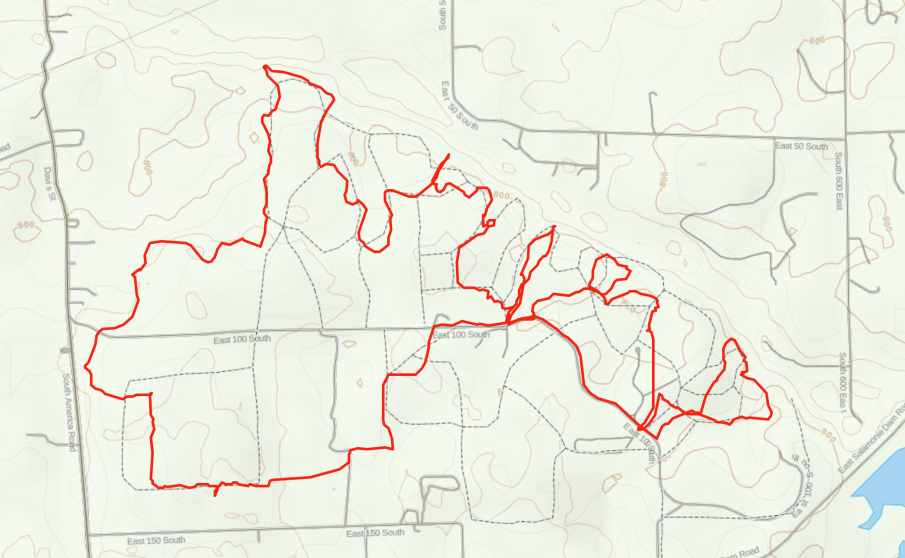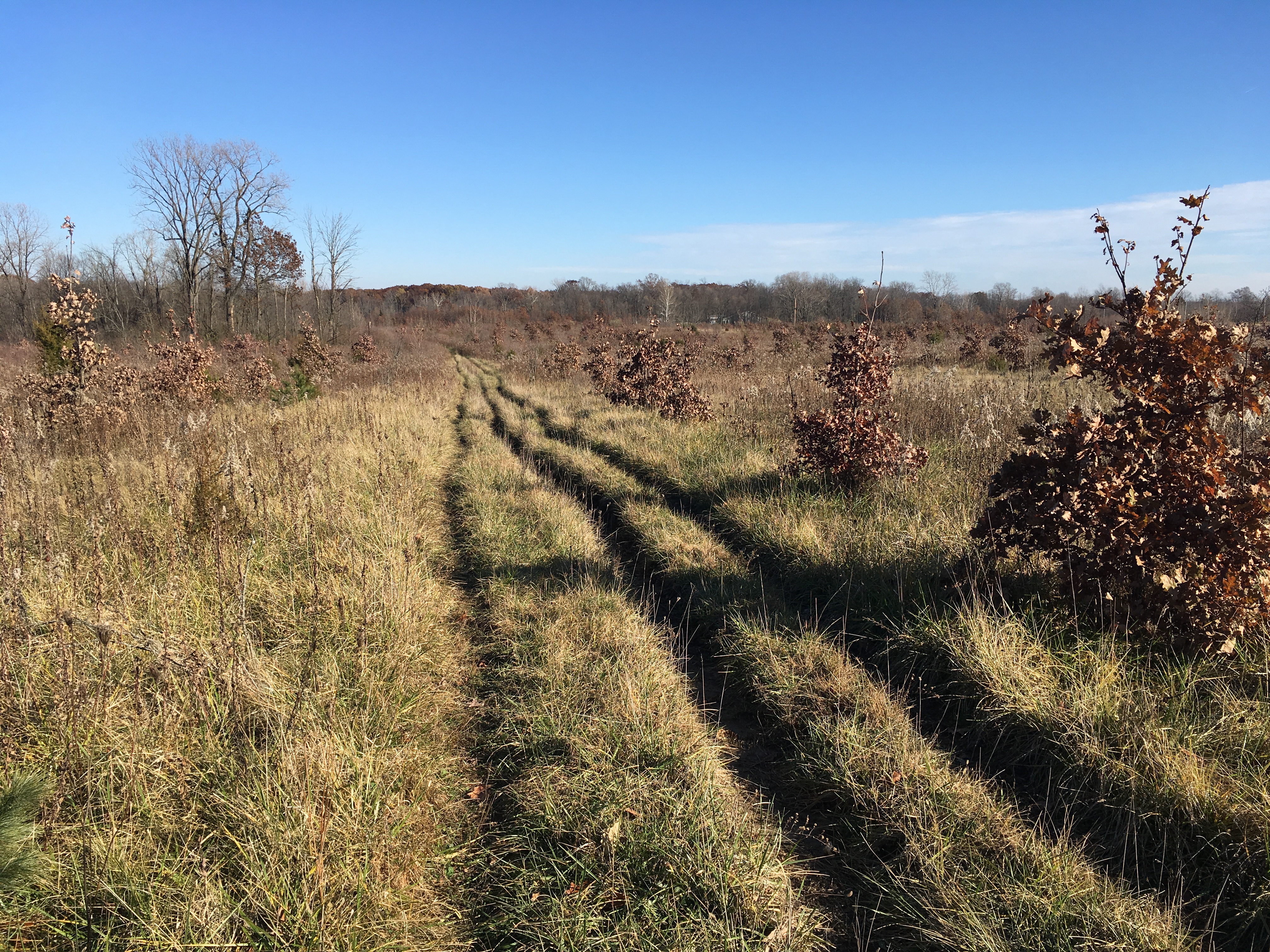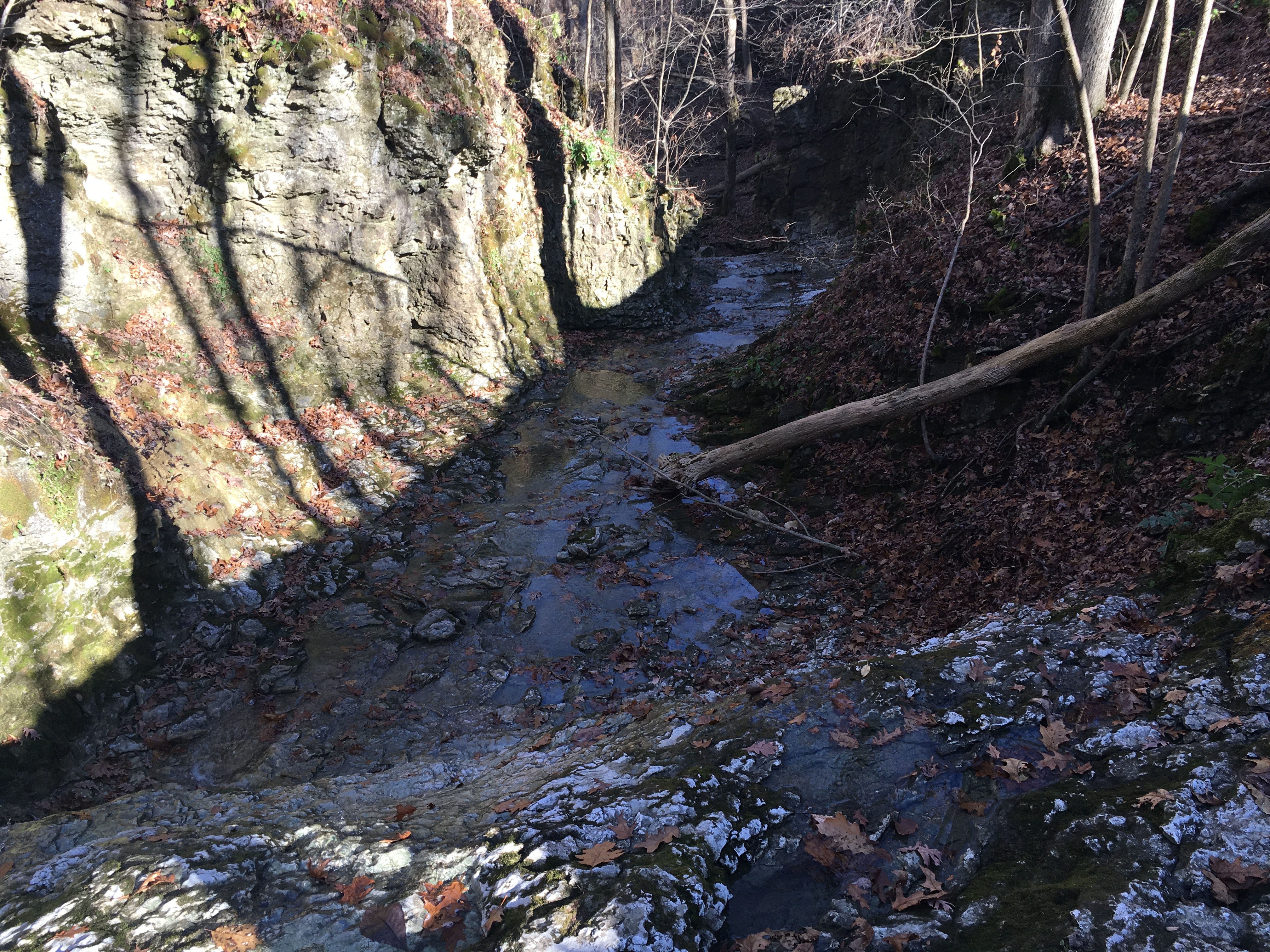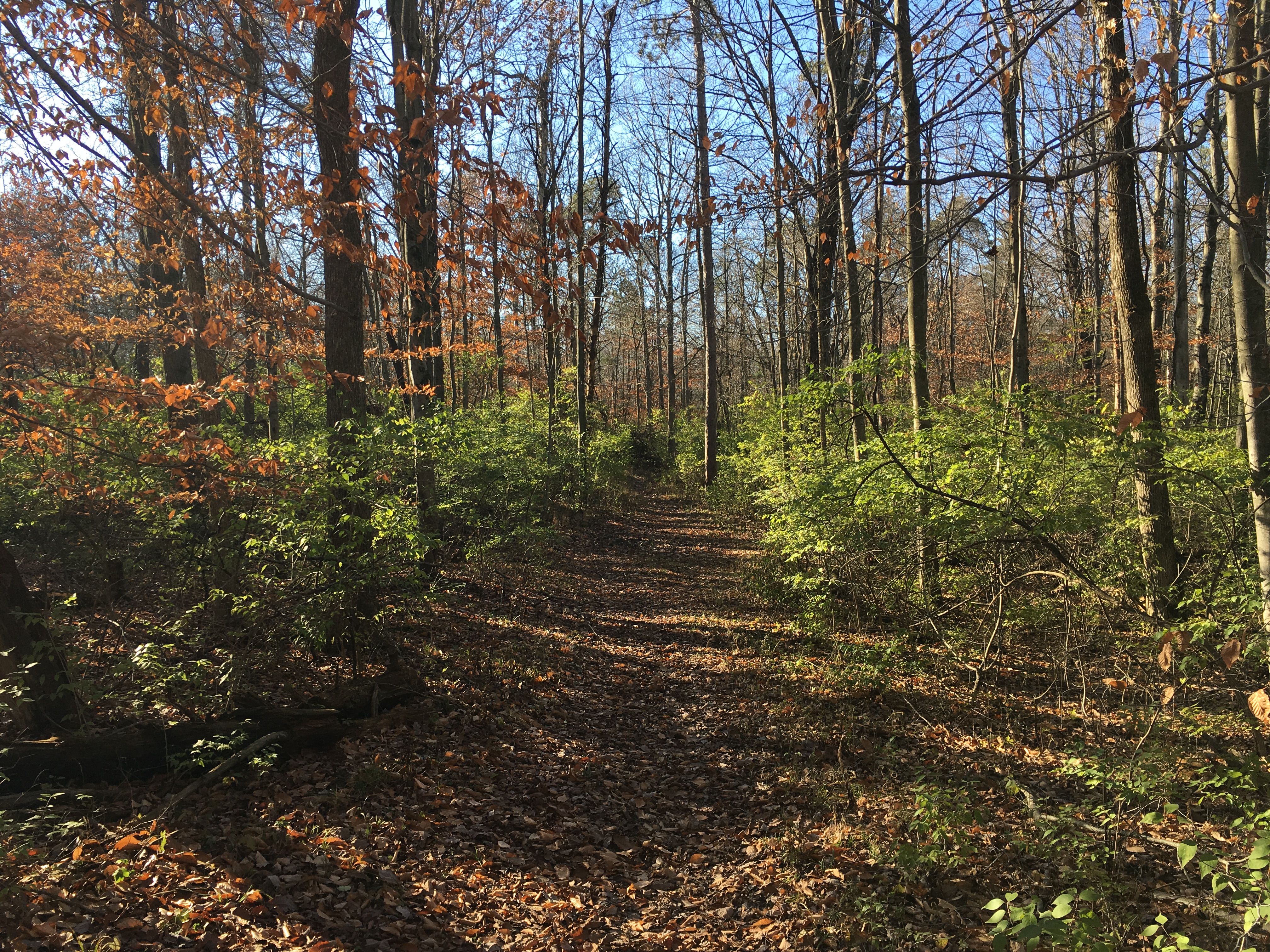
Background Banner
Going out with REI
 My #OptOutside excursion was a hit this year. Salamonie State Forest in northeast Indiana is one of three U.S. Army Corps of Engineers reservoir projects completed in the 1960s to reduce flooding on the Wabash River. Dams were placed on the Roush, Salamonie, and Mississinewa Rivers. The area surrounding Salamonie Reservoir is a testament to the area’s glaciated history, where creeks tributary to the Salamonie River cut steep draws into the hillsides, sending water sluicing over exposed limestone waterfalls up and down the river valley.
My #OptOutside excursion was a hit this year. Salamonie State Forest in northeast Indiana is one of three U.S. Army Corps of Engineers reservoir projects completed in the 1960s to reduce flooding on the Wabash River. Dams were placed on the Roush, Salamonie, and Mississinewa Rivers. The area surrounding Salamonie Reservoir is a testament to the area’s glaciated history, where creeks tributary to the Salamonie River cut steep draws into the hillsides, sending water sluicing over exposed limestone waterfalls up and down the river valley.

My hike consisted of a series of poorly marked loops along horse trails and fire roads, but I hiked the forest extensively as a Scout in my teens. It had been thirty-five years since I’d hiked it with any granularity, and it felt like coming home. What makes the hiking easy even without navigational aid, is that you’ll run into one of two features to put you back on course, either the sheer 80-degree grade down to the Salamonie River to your north, and the county roads to your south, one of which is the main state forest road.
 The sky was nearly cloudless and the temperature reached the upper 40s, which is perfect for going out in a t-shirt and merino sweater. I munched on Cracker Jack when I got hungry and drank just under half a gallon of water. Gaia GPS says that I hiked 8.4 miles, and that seems accurate. I carried a full pack as I usually do to keep my training realistic, with a total weight just over 20 pounds. My biggest problem was the muddy areas where hooves have decimated the trail. Being compliant with Leave No Trace philosophy did in my Under Armor trail runners, which were on their deathbed to begin with, but they went out in style; if you believe mud is stylish.
The sky was nearly cloudless and the temperature reached the upper 40s, which is perfect for going out in a t-shirt and merino sweater. I munched on Cracker Jack when I got hungry and drank just under half a gallon of water. Gaia GPS says that I hiked 8.4 miles, and that seems accurate. I carried a full pack as I usually do to keep my training realistic, with a total weight just over 20 pounds. My biggest problem was the muddy areas where hooves have decimated the trail. Being compliant with Leave No Trace philosophy did in my Under Armor trail runners, which were on their deathbed to begin with, but they went out in style; if you believe mud is stylish.
 My biggest thrill was the amount and diversity of the wildlife I encountered. Top of the list was the many white-tailed deer. I also ran into a couple of ladies on horseback who were out enjoying the weather. Other than the muddy low areas on the horse trails, the path was in good condition. Hiking through the open grassy area south of the main forest road near the entrance brought back memories of hiking with old friends as a Scout. Over the years I had forgotten which state park or forest the area belonged to, but being out in it again purchased instant recall.
My biggest thrill was the amount and diversity of the wildlife I encountered. Top of the list was the many white-tailed deer. I also ran into a couple of ladies on horseback who were out enjoying the weather. Other than the muddy low areas on the horse trails, the path was in good condition. Hiking through the open grassy area south of the main forest road near the entrance brought back memories of hiking with old friends as a Scout. Over the years I had forgotten which state park or forest the area belonged to, but being out in it again purchased instant recall.
I realize that REI’s #OptOutside is a marketing gimmick, but it is a damn good one. That they shutter their stores on Black Friday and encourage their employees to spend the day in nature aligns well with my worldview. I am always more than happy to oblige, and if you scroll through their hashtag on Twitter, you’ll see a couple of pictures from my hike (also available here).
Not Hiking is Killing You
This is a guest post from Aaron over at Free Range Hiking
Hiking is an all-around great workout. Walking is one of the most beneficial exercises that you can do for hearth health according to the American Heart Association, when you add a weighted pack into the mix as well as negotiating (sometimes) strenuous paths in the forest the benefits only increase. But even knowing all that, we still find ways to put that next hiking trip on the back burner in favor of less strenuous activity. So here are eight reasons that putting off that next hiking trip is probably killing you.
- Heart Disease. Heart disease is one of the leading causes of death in men and women over age 40, much of this owing to our increasingly bad diets and a tendency to get less and less physical exercise as we age. The more we sit and watch television, grab artery clogging fast food and generally avoid strenuous activity, the higher our risk of heart disease climbs. But, hiking is one of the best cardio workout around. Nothing gets your blood pumping like carrying extra weight on your back and negotiating fallen trees, mountain paths and burbling streams with views so beautiful, you’ll forget that you’re exercising. So not only will your eyes thank you for going on that trip you’ve been putting off, your heart will too.
- Blood Pressure/ Blood Sugar. High blood pressure and irregular blood sugar are becoming more and more common with younger and younger patients every year. We have an endless supply of starchy, sugary snacks at our fingertips and more and more series piling up on our “binge list” on Netflix. This combination of bad habits can lead to a few extra pounds piling on before you even realize it and aside from bad eating habits and lack of exercise (I hope you’re seeing a pattern here) excess body weight is the leading cause of high blood pressure and those bad habits going on for too long can wreak havoc on your pancreas, eventually leading to irregular blood sugar or even Type 2 Diabetes. But, one of the best ways to drive off high blood pressure and blood sugar problems is to start living a healthier lifestyle by eating better and getting more exercise. So instead of reaching for that soda and binge watching the next season of The Walking Dead, grab a bottle of water, some of your favorite trail snacks and head out for a short hike instead.
- Weak Bones. As we grow older our bodies naturally stop funneling calcium into our bones. A problem that is further compounded for women who have children, because a growing baby will leach the calcium out of their mothers bones if not enough is present in her diet. Inactivity also leads to decreased bone density, which in turn makes it easier to break bones in the event of a fall or other minor accident. But weight bearing exercise is a great way to increase bone density. When our muscles are forced to lift or bear more weight than what they are used to, our bones are forced to support greater weight loads, so our bodies increase our bone density to accommodate the increased load bearing needs. This is why Doctors tell people with bone density problems to begin lifting free weights. But instead of heading to the gym and lifting weights, backpackers carry that weight in their packs.
- Weak legs. Much like the stomach and arms, the legs tend to be one of the first areas that our body looks to store excess body fat. Extra leg and butt fat is less than flattering and are two of the areas that most people wish they could shape and change. Smaller leg muscles and excess body fat in this area also contribute to heart disease and high blood pressure. However, increasing the size of your leg muscles by walking with a weighted pack will help you trim away the excess fat from your legs and butt, and is also good for your heart. Many of the largest muscle groups in your body are in your legs. Your hamstrings, glutes and quads move a lot of blood when they are active. This blood has to be moved by the heart, causing an increased heart rate and improving heart health. It also leads to strong, good looking legs, and who doesn’t want that?
- Weaker core muscles. Your core muscles, i.e. you abs, obliques, hip flexors and back muscles, affect every movement we make in our daily lives. If you’ve ever done an intense core workout, you likely became painfully aware of just how much you use your core in the days following. Not only does a strong core help balance and stability, it also leads decreases your chance of heart disease, diabetes and a long list of other maladies. The opposite is also true, a weak core burns less fat as fuel, makes hernia-type injuries more likely to occur, leads to unflattering belly fat and makes you more susceptible to a laundry list of chronic preventable disease. But, shouldering a weighted pack and navigating your favorite trail passively builds up these muscles groups by holding the weight securely in place while you maneuver with your legs. Carrying weight long distances will quickly build up your core muscles.
- Poor Coordination. We gain absolutely nothing from watching television or sitting around the house. We lose time, gain weight and miss out on cool opportunities to make unforgettable memories. Walking on flat, level ground all the time lulls us into a false sense of security and leads to weaker auxiliary muscles in our legs and core that help up maintain our balance when we’re negotiating difficult terrain or maneuvering over boulders, fallen trees or unstable rocks. But hiking forces us to move over difficult terrain, often up and down gradual to step slopes and across all sorts of rocks, boulders, tree roots, branches, water hazards and undergrowth. This forces our minds and bodies to think and act quickly and builds cognitive awareness that increases our balance.
- Excess body fat. Being sedentary in our daily lives leads to a quick increase in body fat. Any time we don’t burn what we eat, we put on weight in the form of excess body fat and while it is not detrimental to have a little extra body fat, obesity is one of the most deadly chronic diseases in America and thousands more a year are falling into its clutches due to more and more people living sedentary lifestyles. But it’s no secret that hiking burns calories, thru hikers on the AT often lose between 20-50 pounds on the trail, and many are in great shape when they start. With a loaded pack and on moderate to difficult terrain a hiker can burn well north of 3000 calories in a day. Even a one to two hour hike can burn between 800-2000 calories depending on your body weight, the weight in your pack, and the difficulty of the route you’re on.
- Psychological health. We’re biologically designed to live in nature. We’ve evolved over hundreds of thousands of years to find our homeostasis in an outdoor environment. So naturally, when we’re deprived of the environment that our bodies developed to live in, we begin to see negative effects on our psyche and mental health. Because our ancestors lived for so long in the wilderness environment, many of the aspects of being outdoors effect our well being. They became basic needs over a very long time, basic needs that are no longer met by our man made environments. Another basic need that is not met as often as it was in decades and centuries passed is our connection to the community. Human beings are social creatures, but outside of our immediate families, people rarely get outside human interaction anymore. Society teaches us that we should be staying in and consuming artificial entertainment by ourselves or with a few members of our immediate family instead of going out with friends to seek entertainment outside of the home. Hiking is a great past time that only gets better when you include friends. Sitting by a campfire, having a few adult beverages and laughing and talking with friends is a great way to satisfy our need for human interaction and to be out in nature. This is a great way to get your blood pumping and stave off depression. Additionally, getting out and hiking and camping on your own or with close friends is a great way to build confidence in your ability to provide for and take care of yourself in harsh or uncomfortably situations. This builds confidence in what we can do, and helps alleviate anxiety.
So with all of the benefits that hiking brings to the table, extending our life, making us stronger and staving off depression and anxiety. Why do we continue to put off those next hikes? Do we really have anything more important to do? Probably not, so the next time you think of putting off that next hiking trip, remember all of the benefits that you’re passing up.
Top five habits: The all-in foodie
Respect the food!
There is a popular modern slogan that was in part birthed by the slow food crowd. “Farm to Table.” It comes close in describing how we should view food and nutrition. For such an important part of our lives and health, we “farm out” much of the process and products to strangers.
We should be advocates for knowing where our food comes from. If not our own gardens (even herb gardens on the kitchen window sill), then community gardens, farmer’s markets, or community supported agriculture (CSA) ventures. You say that those things don’t exist close to you? And yet we’ll drive thirty miles to the mall for a special purchase or as entertainment. The reason they don’t exist in great numbers is because we haven’t asked for them.
I’m all for small and slow solutions, and since these types of services take time to implement, let’s start asking for them now. It may even be a business opportunity for you; learning the skills now that will allow you to buy land and tools and begin building a clientele.
Something else that we have lost, or are in the process of losing, is the meal time rituals that have been a part of our cultures since time immemorial. The act of planning a meal, getting the ingredients, preparing them, cooking, sharing the food around a table with family and friends is something to be celebrated, not despised. I’m sure that some of your fondest memories are of dinner table conversations. I know some of mine are.
The same people who say that they don’t have time to cook are the same people who sit for an hour with a buzzer in their hand, waiting for a restaurant table. We’re like that when we’re on auto-pilot. One needent slow cook a pot roast for every meal. There are many simple meals with whole food ingredients that can be prepared and served in half an hour completely from scratch. I urge you to give it a try. In doing so, you could also be teaching yourself and even your children and friends a valuable life skill. There are many teens who don’t know a single simple recipe beyond boiling ramen and microwaving pre-packaged faux-food.
Getting into the dinner routine is a simple act of the will, where it isn’t one person’s responsibility to set the table, prepare food, cook, and do dishes. When everyone pitches in and spends time together throughout the process, everything gets done quickly. This is an opportunity for everyone to interact, laugh and talk.
Later, we’ll get into ways that you can get involved locally to promote a more regional food economy, but for now, consider the above. At the least, at every meal, do your best to recreate the food ritual. Meals aren’t only for nutrition, they’re a social act and we should do our part to keep that alive. Don’t eat alone if you can help it, always try to have a healthy meal with friends and conversation.
Who you are
Work is who you think you should be.
Leisure is who you are.
— Anonymous
Top five habits: Attitude
Today is the first in a five part series addressing the top habits that will nudge you toward living at a human scale and pace. A positive and hopeful attitude drives positive gain in our lives. This has been a hot topic in the social sciences lately because of depression and other disorders that are on the rise. We need tools, especially today, to help fight the negativity bias and whatever else may contribute to negativity and despair. In an earlier post, I talked about living deliberately, and that certainly helps. It is difficult or impossible to change if you’re on auto-pilot.
The virtue of self discipline, otherwise known as self mastery, realizes that we don’t operate on instinct by itself, but have the power to use reason and reflection to guide ourselves into the future. If you want it, will it. That will greatly increase your chances of success, but I can guarantee that if you don’t will it, it won’t happen.
The quality of your view depends on where you are standing. It is the same way with perception and our outlook on the world and the circumstances in our life. It isn’t always possible to change our circumstances, but we can always change our behavior – how we react or if we react at all. Making the leap to positivity from negativity or apathy is the most necessary component in any attempt to change for the better.
What are two things you can do to attain a consistent positive attitude? Write it down. This is a popular habit in many circles because it works. At the end of the day, look back and find three things you’re grateful for and why. Then, for the times when you’ll start to get negative again, write them down in a notebook. It helps to have those consistent positive messages to turn to. Second, Mr. Miyagi was right: breathe. Take a minute to put yourself back into your body and in the moment. Nothing works better to get you there than taking deep, calm breaths and focusing on the process. Eyes closed, breathe in through the nose, out through the mouth. Repeat. Have a positive day.
The last of the fog is lifting at Bryant Creek Lake.
The possessive case
 Today, I’m beginning to list, in a very transparent way, everything that I own. I’m doing it in an effort to pare down and focus on people and experiences instead of things. I’m going to be getting rid of the things that either aren’t useful to me or don’t otherwise bring me joy.
Today, I’m beginning to list, in a very transparent way, everything that I own. I’m doing it in an effort to pare down and focus on people and experiences instead of things. I’m going to be getting rid of the things that either aren’t useful to me or don’t otherwise bring me joy.
The process is going to take me awhile, but remember that it is the journey (!) and not so much the destination that matters. I’m being transparent about this to help others out – others who might be considering doing the same thing, other than posting it all for anyone to see.
I’ll be working in my office today, and will go on to other rooms of the house, and God forbid the garage, as time permits. You can watch the list grow by clicking on the “My Stuff” menu tab at the top of my blog. It only has a few things populated into it right now, but come back whenever you want to see it grow, and then get smaller. I’m curious to know exactly how many things I own.
Solace
“The best remedy for those who are afraid, lonely or unhappy is to go outside, somewhere where they can be quite alone with the heavens, nature and God. Because only then does one feel that all is as it should be and that God wishes to see people happy, amidst the simple beauty of nature. As longs as this exists, and it certainly always will, I know that then there will always be comfort for every sorrow, whatever the circumstances may be. And I firmly believe that nature brings solace in all troubles.”
― Anne Frank



